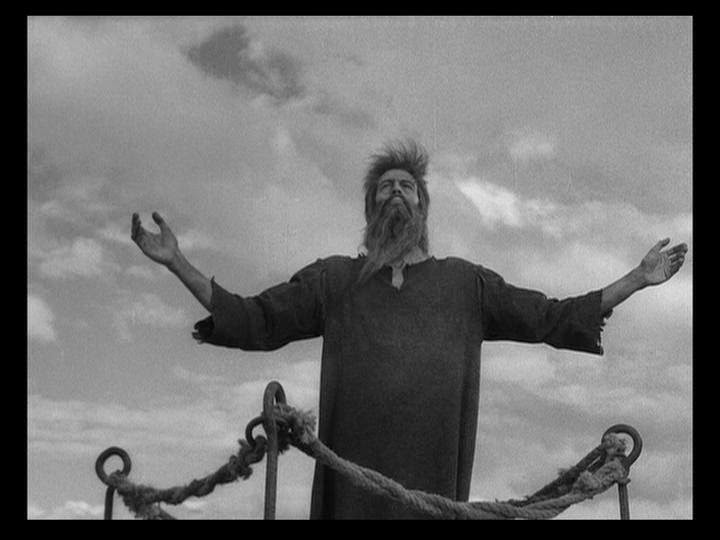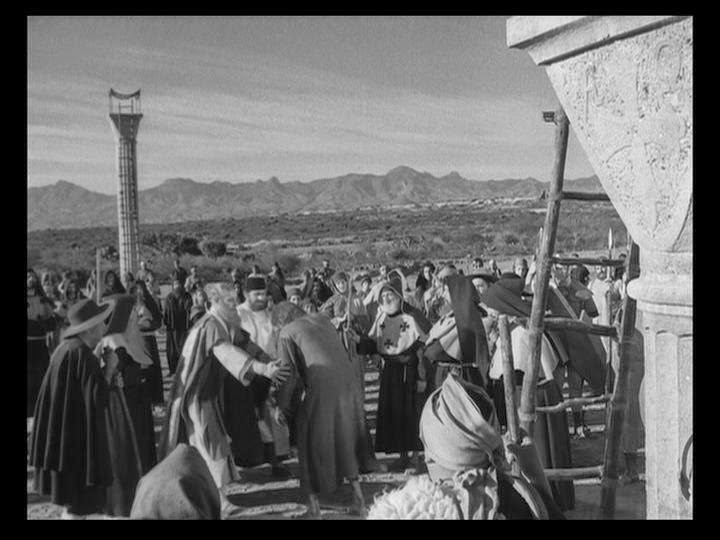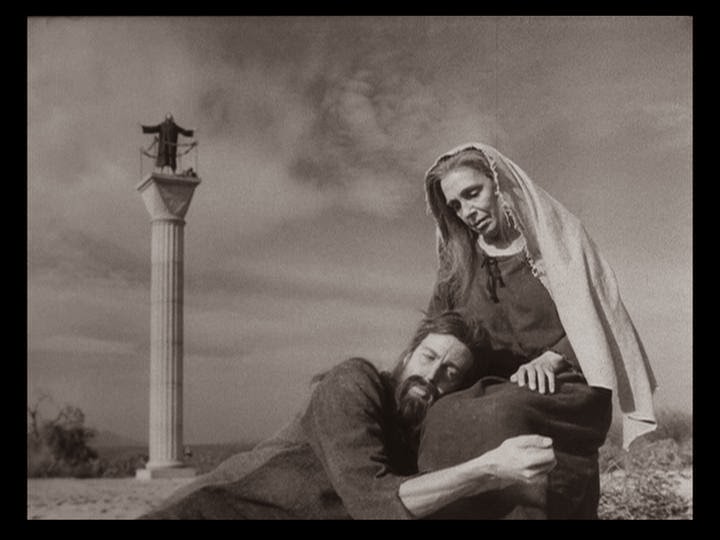This is the third and final part of my old
undergraduate essay on the subject of Luis Bunuel’s auteurism. I
should take this opportunity to highlight that I am well aware that
Bunuel’s name has been incorrectly spelled throughout – I blame
my computer, which does not want to let me access the appropriate
accents.
III. ACTS
While the previous post focused
predominantly on Bunuel’s control over filmic reality (either by
taking on the role of God within the fiction, or shamelessly placing
characters in ‘unnatural’ situations), the films discussed in
this post demonstrate a central component of this control – one
which harkens back to the films discussed in the first post – that
is, the notion of time and space and their somewhat mercurial nature
in cinema.
Both of the themes that were central to
Nazarin and The Exterminating Angel, namely outright
manipulation by Bunuel-the-God and the concerns with faith and
religion, are found succinctly demonstrated and explored in Simon
Of The Desert, Bunuel’s last Mexican film. With a runtime of
less than 50 minutes, the film’s brevity and wit often undermine it
multifaceted themes and fascinating ideas.
The film’s premise is almost like a
sequence from Monty Python’s Life Of Brian; Simon (Claudio Brook) is a
saintly hermit in what appears to be the earliest days of the
Christian faith, revered by the locals as a miracle-worker and pious
Holy Man, he spends his time standing atop a huge pillar, praying up
to the heavens for the sake of the sinful mankind. At the film’s
opening, the priests show their appreciation of Simon by presenting
him with an even taller pillar to stand on. But this is the beginning
of a sequence of events where Simon finds himself confronted with the
temptations and abuses of a distinctly Bunuellian Father of Lies.
The film does not simply present a
narrative of religion and faith, as Nazarin does, but rather
presents an entire cosmology, complete with Devil and God. While in
the other film, we must argue for the existence of God within the
otherwise realist story, in Simon Of The Desert the existence
of God is clear; miracles occur with sledgehammer subtlety – hands
grow back from stumps in front of a crowd of hundreds. However, with
these miracles comes a level of acceptance not found in the previous
post’s films. The return of the man’s hands is met with the same
enthusiasm as a magician’s trick, and both participant and
onlookers are quick to carry on with their lives as if nothing
unbelievable has happened. Within the diegesis, God’s existence is
so certain it is taken completely for granted.
The film’s most interesting character
is clearly the Devil. Played by Silvia Pinal, the lord of Hell here
is earthy rather than evil, espouses views synonymous with Bunuel on
religion as a cause of repression and, as an extension, destructive
perversion. He/She is a shapeshifter, appearing in a variety of
guises, from Edwardian schoolgirls, naked crones and even a highly unconvincing Jesus Christ. The Devil takes
full advantage of the tricks of editing and framing – appearing
behind Simon while he looks at her elsewhere off-screen.
Indeed, Pinal’s character can be seen as the embodiment of Bunuel’s personality incarnated within the diegesis. Equipped, it seems, with her knowledge that everything around her is taking place within a film, the character is a direct link between Bunuel-the-God and the characters of Bunuel’s fiction.
Simon himself, too, is a fascinating character. Much like Nazario, he is a man whose faith is pure but, in actuality, also quite useless. He stands atop his pillar, praying for the world and waiting for God to finally receive him; a vivid visual representation of the faithful’s alienation from the real world. Unlike Nazario, for whom this uselessness becomes a revelation, Simon remains oblivious to simple human nature. His inability to understand the concept of ownership, seems to be presented as ridiculous but also, perhaps, somewhat charming. Bunuel’s ultimate treatment of Simon is in many ways better than his treatment of the Mexican priest; he is allowed to remain in ignorant bliss, his faith never particularly wavering, even in the face of modernity.
The film’s finale sees Simon whisked away by the Devil to a 1960s nightclub. Simon is now dressed in modern garb, complete with beatnik-like haircut, while the Devil sits next to him, moving her body to the music. The brief moment with the two at the table drinking is perhaps the most complex in the film. Simon appears more bored than anything by his surroundings and – through the simple gesture of lighting the Devil’s cigarette – has clearly developed a certain tolerance for his companion. Though there is no clear indication that the Devil has ‘won’; Simon has not been sucked into some lifestyle of debauchery nor is he horrified by his predicament. Despite a mild interest in the name of the dance (‘Radioactive Flesh’) he is perfectly happy to return to his pillar unchanged by the experience. Here – as with Exterminating Angel – we have an example of the characters being allowed to remain ‘pure’, Nazario, the dinner guests, and Simon are not changed directly by Bunuel, only by the circumstances that he has concocted or, in the case of Simon, are not changed at all. Simon’s choice to retain his faith despite all he as been through is in sharp contrast to Nazarin, where faith in humanity is presented as a far greater force.
The common, and most obvious,
interpretation of the ending is that the Devil has brought Simon
forward in time in order that he might see out the last days.
However, given the apparent significance of the Devil’s
relationship to Bunuel and the ease with which Simon believes he can
return home (as if it is another space rather than time), it might be
reasonable to surmise that in fact the Devil has pulled out of
the diegesis and into the real world, the world of Bunuel. Thus the
diegesis can be succinctly viewed as a construct, a created reality
within the world which we inhabit and therefore subject to the rules
fashioned by its creator. Space and time, then, are only as
consistent as deemed necessary for the telling of the story.
But Bunuel’s greatest juggling act of
space and time can be found in his theological epic The Milky Way;
though only 90 minutes, the average length of his films, it seems
considerably longer, its absence of cause-and-effect logic destroys
any frame of reference that an audience might have for gauging the
length of the ‘story’ (such as it is).
Like a series of sketches, or more
accurately parables, the film unfolds at its own pace, following the
incidents that occur to two tramps on their way to Santiago, on a
pilgrimage of sorts. These incidents demonstrate a multitude of
theological views and counter-views, highlighting above all the
contrast between genuine faith (which the director has lightly mocked
in other films but never outright condemned) and the crimes against
humanity for which orthodox religion can be responsible. Much like an
extension of Simon Of The Desert, the film plays with diegetic
reality as much as with time and space – there are no clear-cut
definitions between fantasy, reality, past, present, future, fiction
or flashback.
Within the first few minutes of the
film we are presented with this scene (and I'm not entirely confident about this video working here... if not, I'll just have to post it separately later):
This sequence, barely a few minutes
long, is packed with so much ambiguity and controversy that it could
constitute an essay in itself. Structured in the form of a
traditional flashback; the cut to the female figure that bears a
resemblance to the Virgin Mary and a young man we therefore take to
be Jesus followed by a return to the two tramps would imply that the
Jesus-figure is Pierre, the older tramp, in his younger years. The
dialogue in the two scenes reinforces this interpretation.
In itself, this creates a complex
relationship – Pierre is presented as Jesus, just as Jesus is
presented (via the act of sharpening a razorblade) as Bunuel; a holy
trinity of character, director and God is created. But the complexity
continues beyond this. As the film progresses, we learn that the
figures that we have seen are in fact Jesus and Mary. A
conversation between staff members at a restaurant is punctuated with
examples; one waiter suggests that Jesus must have run and laughed
like anyone, and the film cuts to Jesus running to meet his
disciples. Subsequent appearances by both Jesus and Mary also firmly
place them within the same cinematic time and space as the other
characters, thereby forcing us to reappraise the moment above not as
a flashback but as a cross-cut, a juxtaposition of two separate
actions occurring within the same cinematic timeframe.
But this interpretation also fails as,
after uttering the words “Wise woman, your mother”, the two
tramps come across a boy sat at the side of the road. He is dressed
in a blue shirt and shorts and has drops of blood on his palm, chest
and across his forehead. These stigmatic wounds clearly relate this
child to Christ and we might interpret that the film is going to be
full of different figures who represent different aspects of Jesus
(later in the film the two come across a ‘shepherd who talks like a
priest’). But even this fails to hold up, as the child is the same
boy whose face had been washed by Mary moments before –
simultaneously undermining the possibility that he is the Jesus
figure or that the previous scene had been occurring ‘at the same
time’ as the tramps’ conversation.
The simple cut has rendered any hope of
narrative space/time causality utterly null and void. This will
continue throughout the rest of the film. Historical eras blend into
each other without characters batting an eyelid; the two tramps
settle down for the night but can here the noises of a ceremonial
orgy taking place a few metres away in broad daylight; a priest
advises a young couple about celibacy from both outside and inside
their bedroom; characters appear and disappear without notice.
We have returned to the realms of Un
Chien Andalou and L’Age d’Or. Indeed, the opening of
L’Age d’Or where Imperial Rome is founded upon the final
resting place of a group of Roman Catholic Bishops would fit
perfectly into the logic-defying world of The Milky Way. The
presence of Mary and Jesus within the diegesis makes it clear that in
this world God too must be viewed as real. However, in a more extreme
fashion than either Nazarin or Simon Of The Desert the
reality of God is explicitly negative, presented as the cause of much
discontent. Though Bunuel presents himself as God, this is less a
self-aggrandisement project than it is a case of casting himself in
the role of the villain.
IV. REVELATION
Bunuel’s control over his films’
realities was not only an example of highly individualistic direction
but also a totally distinctive way of creating cinema. He did not
just play God in his films as a response to his own Catholic
upbringing – another way of mocking the establishment – he
created a cinema that was so different to the tradition of
narrative-driven films of the time that playing God was the only way
to direct them.
These intricate diegesis’ were entire
universes unto themselves, working by their own inscrutable laws of
logic. No-one other than their creator could possibly have guided
these tiny existences to their necessary conclusions; Hitchcock could
never have coped with the timeless spaces (or, perhaps, spaceless
times) of The Milky Way. This film was part of the final phase
in the director’s career, one that increasingly looked to the past.
In Belle De Jour, we find in the final sequence a conceptual
remake of the beautiful ‘magic mirror’ sequence from L’Age
d’Or; complete with an inexplicable view to the outside world,
and a characters’ descent into fantasy that appears to almost be a
Pavlovian response to the ringing of Bunuel’s extra-diegetic
bells).
Bunuel’s very last film, That
Obscure Object Of Desire, is clearly a cinematic apocalypse, it’s
final on-screen explosion is both justified within the film’s plot
and functions as a decisive indicator from the director-God that his
cinematic kingdom has run its course. Shortly afterwards, Bunuel
shuffled off this mortal coil and no doubt ascended to meet his maker
– razorblade in hand.
- P.S.






































No comments:
Post a Comment